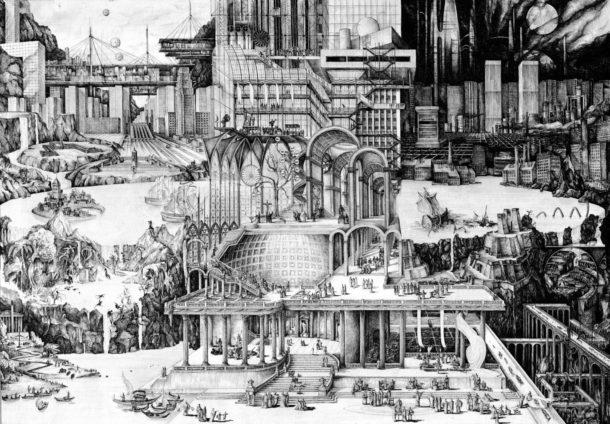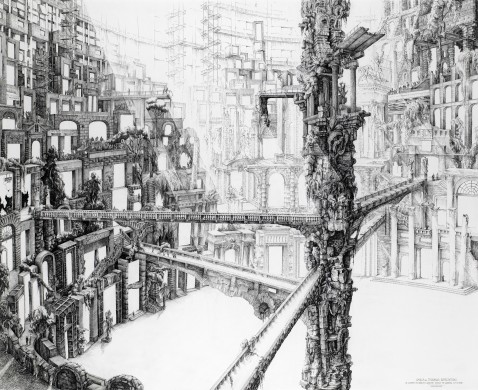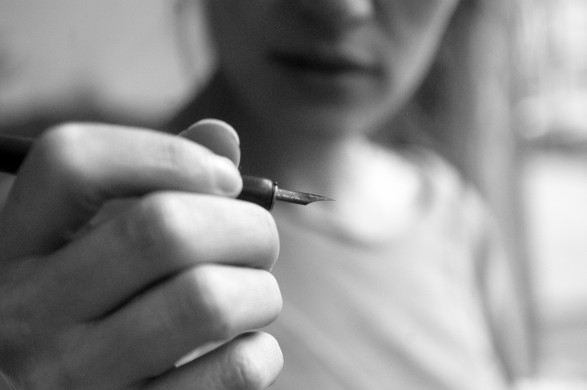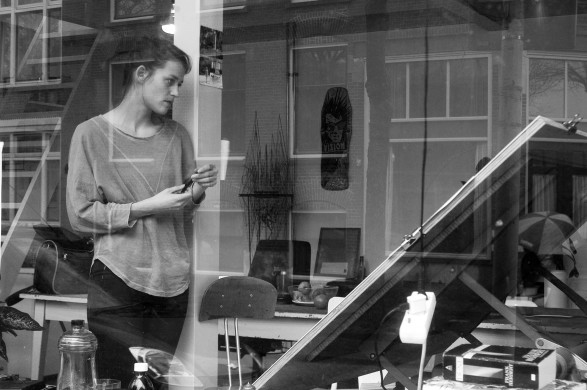World Fine Art Professionals and their Key-Pieces, 148 - Carlijn Kingma
World Fine Art Professionals and their Key-Pieces, 148 – Carlijn Kingma
Last September I was in Rotterdam at the opening of two exhibitions of Galerie Untitled. One was from Sasja Hagens (see an interview with her on this site), the other from Carlijn Kingma. Carlijn Kingma had made architectural drawings in large format, which evoked the world of Bosch, Brueghel, Dante and Constant.
I was impressed. What a details and at the same time grip of the big picture. A special talent with a great future was my thought. That soon came true when I read that she had become artist-in-residence with Joep van Lieshout. A little later I learned that she had been given a solo exhibition at the Gemeentemuseum in The Hague.
Research
I spoke with her for a further explanation of her work in Café Engels at the Stationsplein in Rotterdam. She was there a little earlier than me and used the time to read a book: ‘TechGnosis’ by Erik Davis. A big thick book about myths and mythology in the era of media technology.
Carlijn: “It’s about the interwovenness of the two. I am working on a new drawing about faith. Davis thinks that mythology and religion have not disappeared in the modern world, but moved and hidden in, among other things, new media technologies.” Carlijn reads a lot for every drawing. She also calls in an expert in the field, with whom she can talk about the subject. All in all, about four / five months are involved. Three months of research, two months of drawing.
Stories
Stories
In the first place she wants to tell stories to explain certain aspects of society. “Do we want it this way, or do we want it differently? It generates a lot of discussion, and that is also the intention. My work is moving around Utopia. Not a utopia for dreamers or utopia in the sense of gruesome fantasies. I try to connect the achievable and the desire. It’s a kind of test situation. ”
She moves at the interface between science and art, she maps worlds. “I do cartography, I call myself cartographer, a cartographer of society and thought constructs of society.” She makes a (re) construction of society in maps, each time focussing on another aspect: religion, science , climate, capitalism. “These concepts are abstractions, for some monsters. I want people to understand how it is. I use a metaphorical language in a fictional, architectural world, where people can wander. I want to arouse both understanding and wonder. ”
She makes only a few sketches. It comes at once on a large paper. However, she uses word diagrams. She shows it on her laptop. “Such a map goes all directions, it is an intersubjective spectrum.”
Graduation paper
It all started when she was working on her graduation project in the study Architecture at TU Delft. “I wanted and would like to understand how institutions lead to a certain behavior. In doing so, I had in mind that it is important to live inclusive and sustainable together. There are many conflicts in the world. Why is there more justice with us than with others? As a storyteller, I hope to learn more about it and to contribute to the fight for a fairer society. I felt that I could clarify constructs of society and life through maps. ”
It was not easy, initially. “I have had many problems at university. Everything is about efficiency and quantifiability. What do you do with a utopia? I was lucky with some teachers who gave me the freedom to get started. My project became ‘The School for Utopia’ in which thought was given to the major issues of life. How to live together? What is the meaning of value and ownership? ”
She read 41 books on Utopia, including works by Charles Fourier, Thomas More, Aldous Huxley, Karl Marx, George Orwell and William Morris. “I had to make utopias known in different directions. I started my first drawing with the image of the ideal society of Plato.” Four supervisors she had, and they were all four skeptical. One of them, the philosopher Patrick Healy, started to turn when he saw the first drawing. “In my drawings he read metaphysics.” In the end, he gave her a 10 for the history component, the highest rating.
And the other four supervisors also turned. “Three quarters of a year later I got my architecture diploma for ‘Architecture as utopian language’ based on 40 drawings. I got four more tens. I could not believe it myself. ”
Key work
Can she designate a key work? Two she has. In the first place ‘A history of utopian tradition’, in which we see, among others, Plato, The Garden of Delights (Bosch) and the Inferno of Dante. And in addition, ‘The Babylonian Tower of Modernity’. “How contemporary faith in progress leads to confusion.” We look at the drawing. Left and right are both romantic reactions of society to the rational tower of capital in the middle. On the left we see the adventurers, the belief in abundance, a craving for authenticity, honesty and spontaneity. To the right we see the people who seek security, feel a sense of scarcity, a desire for tradition, safety and preservation. And in the middle the tower of capital. Who will realize the utopia? Carlijn: “At least not the ones in the top of the tower. They have the most interest in maintaining the system. ”
Utopias are needed to change society, according to Carlijn. “The foundation of civilization has been laid by the utopians of the past. We are once again at the start of a tradition, because the current era is coming to its limits. In the new era, property and ownership may decrease in value, individuality, honesty, originality, both intellectually and practically are getting a higher status. ”
Gemeentemuseum
As said, she is more cartographer than artist. “In art I have the feeling that something is sometimes made deliberately difficult to increase the value of the artwork. The image of an artist is just as much a product as the artwork itself. I hope people discover my drawings as a story. That it arouses the understanding and wonder. A tricky question for me is therefore, how much do I give and how much do I let others interpret, I like to leave the necessary space to the viewer. Finally, I hope to encourage the viewer to respond and in this way bring me to new insights. ”
There are four drawings in the Gemeentemuseum and there is a blank sheet where the visitors can give their own reactions. “I was drawing for eight days. With my pen tray I walked through rooms with Mondrians on the wall. Unbelievable! I thought, how can this be? I was almost terrified to be working alongside Mondrian. ”
She needs time and will take it, she says. “It is a big challenge to gather information for each work and to involve good experts. In an ideal scenario I would live with someone at home for each project who has a lot of knowledge of a specific subject and wants to share a story with me, for example about parts of the banking world or journalism. Another scenario for the future could be a collaboration with a newspaper or magazine. ”
Images: 1) A History of the Utopian Tradition, 841 mm x 1189 mm, 2) Spolia or Thousand Expectations, 3) The Babylonian Tower of Modernity, 4) Carlijn Kingma, photo Hans Werlemann, 5) Carlijn Kingma in studio, photo Hans Werlemann
http://carlijnkingma.com/
http://www.untitled2011.com/
https://www.gemeentemuseum.nl/nl/museum/nieuws/tentoonstelling-new-babylon-award
https://ifthenisnow.eu/nl/verhalen/de-wereld-van-de-rotterdamse-kunstenaar-33-carlijn-kingma
Disclaimer: The views, opinions and positions expressed within this guest article are those of the author Walter van Teeffelen alone and do not represent those of the Marbella Marbella website. The accuracy, completeness and validity of any statements made within this article are not guaranteed. We accept no liability for any errors, omissions or representations. The copyright of this content belongs to Walter van Teeffelen and any liability with regards to infringement of intellectual property rights remains with the author.




















The opinions expressed by individual commentators and contributors do not necessarily constitute this website's position on the particular topic.